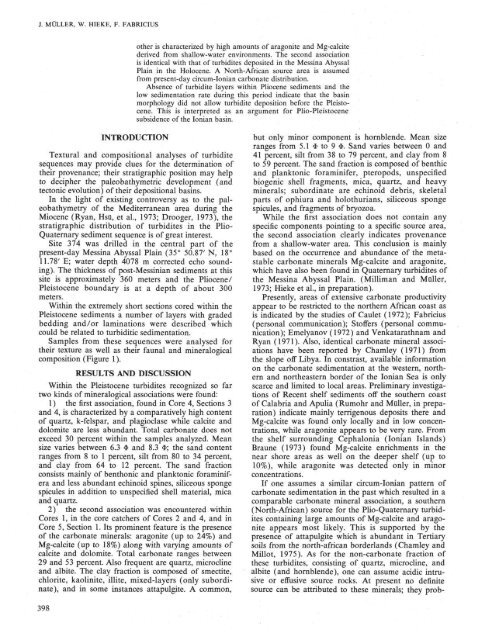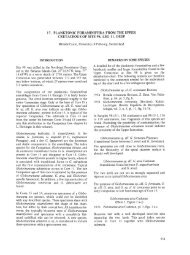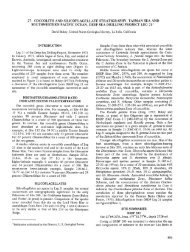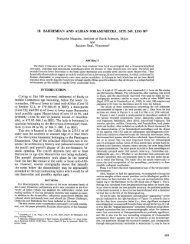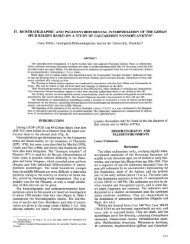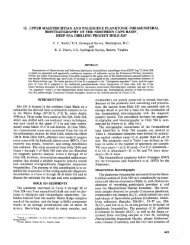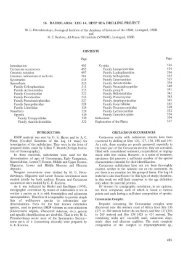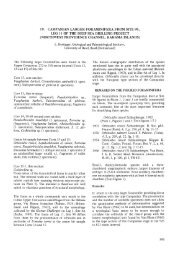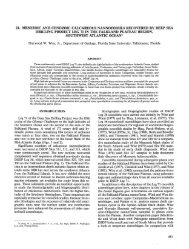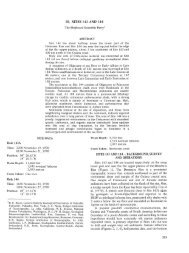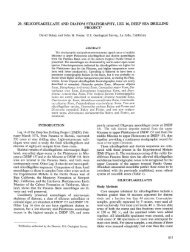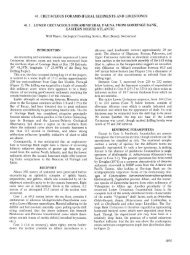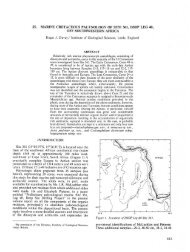Deep Sea Drilling Project Initial Reports Volume 42, Part 1
Deep Sea Drilling Project Initial Reports Volume 42, Part 1
Deep Sea Drilling Project Initial Reports Volume 42, Part 1
Create successful ePaper yourself
Turn your PDF publications into a flip-book with our unique Google optimized e-Paper software.
J. MULLER, W. HIEKE, F. FABRICIUS<br />
INTRODUCTION<br />
other is characterized by high amounts of aragonite and Mg-calcite<br />
derived from shallow-water environments. The second association<br />
is identical with that of turbidites deposited in the Messina Abyssal<br />
Plain in the Holocene. A North-African source area is assumed<br />
from present-day circum-Ionian carbonate distribution.<br />
Absence of turbidite layers within Pliocene sediments and the<br />
low sedimentation rate during this period indicate that the basin<br />
morphology did not allow turbidite deposition before the Pleistocene.<br />
This is interpreted as an argument for Plio-Pleistocene<br />
subsidence of the Ionian basin.<br />
Textural and compositional analyses of turbidite<br />
sequences may provide clues for the determination of<br />
their provenance; their stratigraphic position may help<br />
to decipher the paleobathymetric development (and<br />
tectonic evolution) of their depositional basins.<br />
In the light of existing controversy as to the paleobathymetry<br />
of the Mediterranean area during the<br />
Miocene (Ryan, Hsü, et al., 1973; Drooger, 1973), the<br />
stratigraphic distribution of turbidites in the Plio-<br />
Quaternary sediment sequence is of great interest.<br />
Site 374 was drilled in the central part of the<br />
present-day Messina Abyssal Plain (35° 50.87' N, 18°<br />
11.78' E; water depth 4078 m corrected echo sounding).<br />
The thickness of post-Messinian sediments at this<br />
site is approximately 360 meters and the Pliocene/<br />
Pleistocene boundary is at a depth of about 300<br />
meters.<br />
Within the extremely short sections cored within the<br />
Pleistocene sediments a number of layers with graded<br />
bedding and/or laminations were described which<br />
could be related to turbiditic sedimentation.<br />
Samples from these sequences were analysed for<br />
their texture as well as their faunal and mineralogical<br />
composition (Figure 1).<br />
RESULTS AND DISCUSSION<br />
Within the Pleistocene turbidites recognized so far<br />
two kinds of mineralogical associations were found:<br />
1) the first association, found in Core 4, Sections 3<br />
and 4, is characterized by a comparatively high content<br />
of quartz, k-felspar, and plagioclase while calcite and<br />
dolomite are less abundant. Total carbonate does not<br />
exceed 30 percent within the samples analyzed. Mean<br />
size varies between 6.3 Φ and 8.3 Φ; the sand content<br />
ranges from 8 to 1 percent, silt from 80 to 34 percent,<br />
and clay from 64 to 12 percent. The sand fraction<br />
consists mainly of benthonic and planktonic foraminifera<br />
and less abundant echinoid spines, siliceous sponge<br />
spicules in addition to unspecified shell material, mica<br />
and quartz.<br />
2) the second association was encountered within<br />
Cores 1, in the core catchers of Cores 2 and 4, and in<br />
Core 5, Section 1. Its prominent feature is the presence<br />
of the carbonate minerals: aragonite (up to 24%) and<br />
Mg-calcite (up to 18%) along with varying amounts of<br />
calcite and dolomite. Total carbonate ranges between<br />
29 and 53 percent. Also frequent are quartz, microcline<br />
and albite. The clay fraction is composed of smectite,<br />
chlorite, kaolinite, illite, mixed-layers (only subordinate),<br />
and in some instances attapulgite. A common,<br />
398<br />
but only minor component is hornblende. Mean size<br />
ranges from 5.1 Φ to 9 Φ. Sand varies between 0 and<br />
41 percent, silt from 38 to 79 percent, and clay from 8<br />
to 59 percent. The sand fraction is composed of benthic<br />
and planktonic foraminifer, pteropods, unspecified<br />
biogenic shell fragments, mica, quartz, and heavy<br />
minerals; subordinate are echinoid debris, skeletal<br />
parts of ophiura and holothurians, siliceous sponge<br />
spicules, and fragments of bryozoa.<br />
While the first association does not contain any<br />
specific components pointing to a specific source area,<br />
the second association clearly indicates provenance<br />
from a shallow-water area. This conclusion is mainly<br />
based on the occurrence and abundance of the metastable<br />
carbonate minerals Mg-calcite and aragonite,<br />
which have also been found in Quaternary turbidites of<br />
the Messina Abyssal Plain. (Milliman and Müller,<br />
1973; Hieke et al., in preparation).<br />
Presently, areas of extensive carbonate productivity<br />
appear to be restricted to the northern African coast as<br />
is indicated by the studies of Caulet (1972); Fabricius<br />
(personal communication); Stoffers (personal communication);<br />
Emelyanov (1972) and Venkatarathnam and<br />
Ryan (1971). Also, identical carbonate mineral associations<br />
have been reported by Chamley (1971) from<br />
the slope off Libya. In constrast, available information<br />
on the carbonate sedimentation at the western, northern<br />
and northeastern border of the Ionian <strong>Sea</strong> is only<br />
scarce and limited to local areas. Preliminary investigations<br />
of Recent shelf sediments off the southern coast<br />
of Calabria and Apulia (Rumohr and Müller, in preparation)<br />
indicate mainly terrigenous deposits there and<br />
Mg-calcite was found only locally and in low concentrations,<br />
while aragonite appears to be very rare. From<br />
the shelf surrounding Cephalonia (Ionian Islands)<br />
Braune (1973) found Mg-calcite enrichments in the<br />
near shore areas as well on the deeper shelf (up to<br />
10%), while aragonite was detected only in minor<br />
concentrations.<br />
If one assumes a similar circum-Ionian pattern of<br />
carbonate sedimentation in the past which resulted in a<br />
comparable carbonate mineral association, a southern<br />
(North-African) source for the Plio-Quaternary turbidites<br />
containing large amounts of Mg-calcite and aragonite<br />
appears most likely. This is supported by the<br />
presence of attapulgite which is abundant in Tertiary<br />
soils from the north-african borderlands (Chamley and<br />
Millot, 1975). As for the non-carbonate fraction of<br />
these turbidites, consisting of quartz, microcline, and<br />
albite (and hornblende), one can assume acidic intrusive<br />
or effusive source rocks. At present no definite<br />
source can be attributed to these minerals; they prob-


